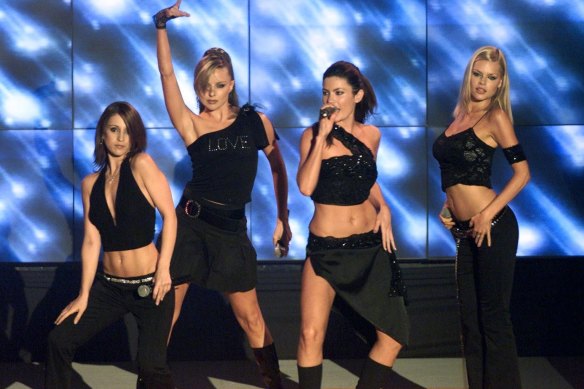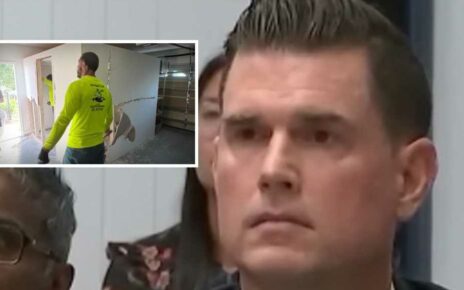By Debi Enker
Save articles for later
Add articles to your saved list and come back to them any time.
The old jail is rockin’. Inside the sinister sandstone walls of the decommissioned Parramatta Jail, the former chapel is alive with colour and music as Harlow takes the stage. The members of the fictional girl group are out-fitted in their customarily skimpy style, this time curve-hugging costumes featuring a camo pattern that’s oddly appropriate given the combative conditions. The band has been booked to perform at the hardcore Reformatory Festival, an event patronised by goths, punks and emos, and it needs to win over an unimpressed audience more inclined to cheer death metal than an upbeat number from a pop group born of a reality-TV show.
Courtney Monsma, Miah Madden, Naomi Sequeira, Emalia, and Courtney Clarke in Paper Dolls.Credit: Paramount+
Compounding the already challenging circumstances, Annabel (Naomi Sequeira) is struggling on stage, requiring both emotional and physical support from her bandmates following a serious meltdown, and there’s concern that she might not make it through their number.
It’s the fourth episode of the new, eight-part drama, Paper Dolls, and it contains many of the elements that feature through the series: an energetic, tightly choreographed music number; a degree of tension because the stakes are high; and a suspenseful undercurrent as the members of Harlow need to get their act together if they’re to succeed.
Enthusing about the prison as a location, production designer Jamie Cranney explains, “Through the series, we were always thinking about how we could elevate the experience and make it cinematic. We didn’t want a music festival that was an open field, with a white marquee and demountables and portaloos,” he says, referencing the familiar Glastonbury look. “We didn’t want to settle for something that we’ve seen before.”
Created by Ainslie Clouston, Paper Dolls is based on an original concept by Belinda Chapple. In 1999, Chapple was one of the young women cast by Channel Seven’s reality-TV show, Popstars, to become part of the girl group, Bardot. Its rapid rise to fame, from shopping-mall appearances to arena tours, was chronicled by the show and Chapple has written about the experience in her recently published memoir, The Girl in the Band.
Naomi Sequeira in Paper Dolls.Credit: Paramount+
“Belinda took her concept to Helium Pictures (Mystify, Last King of the Cross),” Clouston recalls. “And they reached out and asked me to help develop it further.” From there, work began on the characters who would make up the band. “Each of the first five episodes taps into one of the girl’s points of view,” says Clouston. “We worked with a clinical psychologist to look at the psychological effects of fame and how people are drawn to it. What was most interesting to me was why people want it, that it can be driven by some kind of wound within them. Fame both exacerbates a feeling of inadequacy, or whatever that core wound is, and soothes it, so there’s an external validation. We started building these fictional characters around their psychological connection to fame.”
Set in 1999, the series opens with Izzy (Emalia), a former teen sensation and current pizza-shop employee, eager for another shot at success. She talks her way into the group created for the TV show Pop Rush, which already includes Annabel, Jade (Courtney Clarke), Charlie (Miah Madden) and Lillian (Courtney Monsma). Their progress is tightly controlled by Margot (Emma Booth), the seen-it-all-before head of marketing at Millennium, the music company headed by Roger (Ditch Davey).
‘They’re very aware of how disposable they are, that they’re part of a machine.’
In what was to become a familiar reality-TV set-up, but in these early days of the genre was still a novelty, the bandmates live together, their experiences captured by Pop Rush’s cameras. Cranney describes his vividly colourful design for the Harlow house as having “a hyper-real, maximalist Jetsons kind of feel”. The only room free from a prying camera lens is the bathroom.
It quickly emerges that all of the band members are concealing secrets, fears and insecurities. “With each episode we see what each of the girls is hiding from the world, and hiding from the music industry, so that they can keep their place in the group,” says Sequeira. Borrowing a slogan from the production playbook, she describes Paper Dolls as “glossy but gritty”.
Sequeira sees her character as “free-spirited, no filter, honest”. She adds, “Annabel has this main-character energy about her. Even though she’s always trying to get ahead, she stays loyal to the group and she’s grateful for the experience because she didn’t come from much.” Annabel’s delighted when the band’s manager, Teddy (Thomas Cocquerel), assigns her the persona of “provocative wild child” while others get labels like “sexy schoolgirl” and “seductive ingenue”.
Bardot, from left, Sally Polihronas, Belinda Chapple, Tiffany Wood and Sophie Monk, performing in Kuala Lumpur.Credit: Bazuki Muhammad
Regarding the drama’s perspective, Clouston says, “We were looking at the music industry of the ’90s and the manufactured groups of that era. Pop culture at the time was a very masculine, with films like American Pie, and it was a toxic masculinity. Paper Dolls is about the commodification of talent, about how you go from being a person to a product in the eyes of a big institution, and the psychological damage that comes from the girls realising who they are as people no longer matters. They’re very aware of how disposable they are, that they’re part of a machine. They all want solo careers, but they’re in a group and the machine constantly pits them against each other.”
How much change the new millennium has brought to the industry is probably debatable, but Clouston explains, “We’re leaning into the fact that in the ’90s people wanted to hear female artists: the Spice Girls were coming out, there was Girl Power. But in terms of women actually having a voice in the industry, about what they looked like, about what they sang, about how they were treated, they didn’t have one.”
When it came to casting, Clouston says the producers were looking for “triple threats”, performers who could sing, dance and act. Sequeira recalls that she and the other hopefuls all initially auditioned for the role of Izzy before testing for other parts. However there was no chemistry testing to assess the group dynamics before the final five were selected. As with the members of Harlow, the chosen few met for the first time once they were cast.
Back at the jail, halfway through the 12-week shoot in March, the actors run through take after demanding take of the song, All Night, stomping their bare feet, singing, dancing, tossing their hair, working hard to portray Harlow’s efforts to win over the crowd. The chapel becomes increasingly claustrophobic as atmosphere-producing smoke is pumped into the space crammed with 100 extras, three cameras plus another swinging overhead on a crane, as well as the roving Pop Rush camera crew.
Harlow’s high-energy performance, repeated multiple times over hours of a night shoot offers some indication of the commitment and stamina required of the cast in a production schedule that also includes dance rehearsals on Saturdays and music-studio sessions to record Harlow’s songs.
It’s no surprise that 28-year-old Sequeira says that after the shoot she had “a bit of a physical and mental blowout”. She now does regular gym sessions as well as martial-arts and strength training with the aim of being fit for the action-movie role that she hopes to land in the future.
It seems as though Paper Dolls has provided some useful preparation.
Paper Dolls is premiering on Paramount+ from Sunday, December 3.
Find out the next TV, streaming series and movies to add to your must-sees. Get The Watchlist delivered every Thursday.
Most Viewed in Culture
Source: Read Full Article





